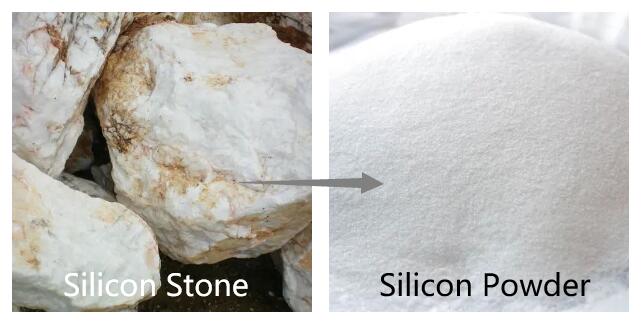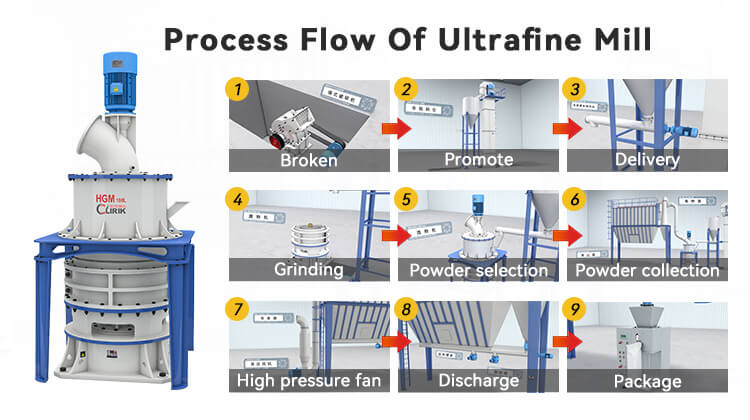For product information and pricing, Chat with sales agent:
or email us : sales@clirik.com
Click links below to see related products.

Silicon stone, a compound primarily composed of silicon and oxygen atoms, holds immense significance across various industries due to its exceptional properties.
From electronics to construction and beyond, the demand for finely processed silicon stone has surged in recent years.
In response to this demand, advanced grinding technologies have emerged, with ultrafine grinding mills leading the charge.

Silicon stone, often found in the form of quartz or silicon carbide, is renowned for its remarkable hardness, thermal stability, and electrical conductivity.
However, in its raw state, silicon stone may not exhibit the desired properties required for specific applications.
Hence, grinding plays a pivotal role in transforming raw silicon stone into finely ground particles with tailored properties.
Silicon stone grinding involves the utilization of specialized equipment designed to reduce silicon stone into smaller, more refined particles.
This process enhances the surface area, reactivity, and overall utility of silicon stone across a diverse array of applications.
At the forefront of silicon stone grinding are ultrafine grinding mills, which excel in achieving particle sizes in the nanometer or submicron range.

The utilization of ultrafine grinding mills offers numerous advantages over conventional grinding methods when processing silicon stone.
1. Finer Particle Size Distribution: Ultrafine grinding mills are capable of producing silicon stone particles with unparalleled fineness, typically in the nanometer or submicron range. This exceptional level of particle size control enables superior performance in various applications, including electronics, ceramics, and advanced materials.
2. Enhanced Reactivity: Finely ground silicon stone exhibits increased surface area and reactivity, leading to improved performance in catalytic, electronic, and optical applications. Ultrafine grinding facilitates the exposure of active sites on the surface of silicon stone particles, thereby enhancing their chemical and physical properties.
3. Improved Mechanical Properties: Silicon stone particles processed using ultrafine grinding mills demonstrate enhanced mechanical properties, such as strength, hardness, and abrasion resistance. This makes them suitable for use in structural materials, abrasives, and cutting tools, among other applications.
4. Optimal Dispersion: Ultrafine grinding mills ensure uniform dispersion of silicon stone particles within matrices or suspensions, resulting in improved homogeneity and performance in composite materials, coatings, and adhesives. The uniform distribution of finely ground silicon stone enhances the properties and functionality of the final product.
5. Tailored Functionality: The precise control afforded by ultrafine grinding mills allows for the customization of silicon stone particles to meet specific application requirements. By adjusting grinding parameters such as residence time, grinding media, and rotational speed, manufacturers can tailor the properties of the final product to achieve desired outcomes.
6. Energy Efficiency: Despite their high-performance capabilities, ultrafine grinding mills have demonstrated significant improvements in energy efficiency over conventional grinding technologies. Advanced design features, coupled with optimized process parameters, contribute to reduced energy consumption and operational costs.
7. Environmental Sustainability: Ultrafine grinding mills promote sustainability by minimizing waste generation and resource consumption. By producing finely ground silicon stone with enhanced properties, these mills contribute to the efficient utilization of raw materials and the reduction of environmental impact associated with traditional grinding methods.
The ultrafine ground silicon stone produced through advanced grinding technologies finds application across a wide spectrum of industries and sectors, including:
Electronics: Silicon stone particles serve as essential components in semiconductor devices, integrated circuits, and photovoltaic cells due to their electrical conductivity, thermal stability, and optical properties.
Ceramics: Ultrafine ground silicon stone is utilized in the production of high-performance ceramics, such as silicon nitride, silicon carbide, and advanced refractory materials, for their exceptional hardness, wear resistance, and thermal conductivity.
Advanced Materials: Silicon stone nanoparticles find application in advanced materials science, including nanocomposites, nanofluids, and nanomembranes, owing to their unique mechanical, electrical, and optical properties.
Abrasives and Cutting Tools: Finely ground silicon stone particles serve as abrasive grits in grinding wheels, sandpapers, and cutting tools, providing superior hardness, sharpness, and durability for precision machining and surface finishing applications.
Pharmaceuticals and Cosmetics: Ultrafine ground silicon stone is utilized as an excipient in pharmaceutical formulations, cosmetics, and personal care products for its inertness, biocompatibility, and textural properties.
The utilization of ultrafine grinding mills represents a paradigm shift in the processing of silicon stone, unlocking its full potential for diverse industrial applications.
By achieving unparalleled levels of particle size control, reactivity, and functionality, these advanced grinding technologies enable innovation and advancement across industries ranging from electronics to ceramics to pharmaceuticals.
As the demand for finely ground silicon stone continues to grow, the adoption of ultrafine grinding mills will play a pivotal role in driving progress, sustainability, and excellence in materials science and engineering.
